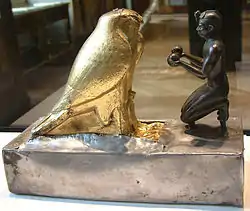List of portraiture offerings with Ancient Egyptian hieroglyphs
This is a list of portraiture offerings with Ancient Egyptian hieroglyphs.

Milk vessel determinative, (lower right column); also the actual Milk vessels being offered
The two major uses of Egyptian language hieroglyph offerings are the wall reliefs, and statuary; minor uses might be thought of as minor statues, charms, or amulets. Many of the sphinx statues are shown with an offering vessel.
List of common offering vessels
- This list is incomplete; you can help by expanding it.
The common nu pot
is the iconography where all offering pots are based. A simple one based on it is the incense censor pot, with a flame of smoke,
.
Many other types of offerings, represented by Egyptian language hieroglyphs are made, by the pharaoh himself/herself in portraiture, or by the gods that are portrayed with offerings.
Incense pot

Nw pot, and "decorated-fringe" pot
Items from the Gardiner's Sign List of Temple Furniture and Sacred Emblems, (section R).
- Censer pot, with vapors-
.
- Censer arm-
.
- Offering of an altar-
.
Liquid vessels
_004.jpg.webp)
Liquids being offered from vessel
Liquid vessels.
- Vessel with liquid stream-
.
- Common nu vessel-
.
Other miscellaneous offerings
- Field of Dreams-
.
(field of reeds)
Gallery of statuary with offering vessels
Monumental type
 6th Dynasty, 24th-23rd century BC
6th Dynasty, 24th-23rd century BC 19th century BC
19th century BC
See also
This article is issued from Wikipedia. The text is licensed under Creative Commons - Attribution - Sharealike. Additional terms may apply for the media files.

